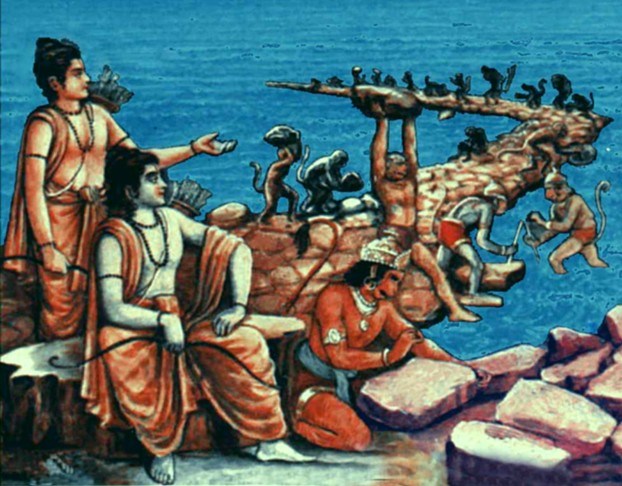By Shrijay Seth
It takes a wise person to look at the story of Ramayana beyond it’s obvious standing as a legendary epic. It can be seen as a way to learn, to educate oneself.
From every Epic written, there are lessons to learn. Be they religious, moral, ethical or even managerial and entrepreneurial.
The legendary Indian epic tale of Ramayana too has lessons to teach – especially in leadership, governance, entrepreneurship and management.
Hence every manager should look deeper, go beyond the text in epics, especially in the Ramayana. There are plenty of lessons for managers to be learnt from Ramayana.
Here are the 5 things that one can learn from Ramayana and inculcate those in their professional life.
1. Form Strategic Alliances through Business Relations
The character of Sugreeva was seen pretty prominent as the one with a lot of managerial characteristics.
He showed traits of a great manager by getting Ram to work consequently and getting back his kingdom from a brother stronger who was than him.
His managerial skills are evident in an instance when he had Angad to work for him. Imagine if Sugreeva was a mediocre manager; Angad could have become one of his arch-rivals.

Lesson: A managerial lesson here is to help businesses run smoothly based on cordial relationships.
And an ideal manager has healthy relations with employees, clients, etc. This results in positive results for the organization. Lord Rama was known to foster such amicable relations everywhere he went.
For instance, when Ravana was in his deathbed, Rama enlightened Ravana with all the necessary life lessons that he learnt in his life.
2. It takes a true leader to make more leaders
When Hanuman was successful in locating Sita, he reduced Lanka to ashes.
This act by Hanuman disgruntled Rama and then he disallowed Hanuman from taking further decisions on his own.
And since Rama knew that he has to live by example, he excluded himself in future where further decision-making was involved.
This helped Hanuman to revive his own decision-making abilities.

It is well known in the tale of Ramayana that Mahiravan abducted Rama and Lakshman to drag them to Patal Lok.
Hanuman then used intellect and physical prowess to smartly rescue them.
It all boiled down to Hanuman’s decision-making that helped him to rescue Ram and Lakshman.
Here, Ram did what every great leader should be doing– creating more leaders within the organization to succeed in achieving a common goal.
Lesson: A true leader and entrepreneur creates leaders around him. It is quite a task but will create people in the organization, capable of taking independent decisions in the right direction.
3. Keeping Communication as the Key
We are aware about the battle of Bali and demon Mayavee.
In one of their fights, they landed in a cave where Bali ordered Sugreeva to stay out.
He asked him to keep a watch over the cave and promised that he will return.
After a year’s wait when neither of Bali or the Mayavee (demon) came out, Sugreeva ‘thought’ they must be dead. He then returned to Kishkindha (their kingdom) and declaring his brother dead, ascended to the throne. He also married Tara, Bali’s wife.
But, Bali returned later conquering Mayavee. But he saw Sugreeva as a king and his wife as Sugreeva’s wife and this made him feel betrayed.
Lesson: The cause of the enmity between the two brothers is miscommunication. Here is an entrepreneurial lesson of not to assume things and act.
Actions should be based on facts to avoid problems in the future.
4. Succession Planning
The epic of Ramayana presents the issues of succession planning very well. This comes when the king of Ayodhya, Dasaratha’s wants to place Rama at the helm of affairs but he was opposed by his wife, Kaikeyi.
Lord Dasaratha’s desire to make Ram the king was obvious – especially since Rama was the eldest of all. Also, he was liked by all people in the kingdom.
And if we refer to the Raghuvansham of poet Kalidasa the Ramyana is extended to Luv-Kush (Ram’s children).
Rama gave the powers of kingdom to his heirs. That is when he decided to divide the kingdom equally between both his sons, Lava and Kusha.
Lesson: Successful entrepreneurs always have visionary plans for their best performers and employees.
Good leaders are experts in grooming potential managers and other employees to ascertain long-term commitment.
5. Efficient management with available resources
Rama is recognized as an epitome of a skilful manager who has a knack of putting to use the available resources in the most optimal manner to gain the maximum out of minimum. Such skills are highly visible during the war with Ravana. One of such skills comes to life when he builds the A-team to construct a bridge over the sea as a road to Lanka.

Ram proceeded by taking first 3 days to meditate and came up with a conclusion to create the bridge.
He got the right people for the right job – Nal and Nila.
These two were skilled in construction and geography.
They also gathered the local tribe with the help of lord Ram which includes the army of apemen.
Rama also trained his team to offer help to Nal and Nila in building the bridge efficiently.
The bridge got in place within the few days and it helped Ram and army to reach Lanka through that bridge quite easily.
Lesson: Successful managers have a knack of equipping the right people for the right task.
An ideal management scenario is to have the people to stay motivated and using their skills for the best output.
Rama vested the responsibility to build the bridge on Nal and Nila and he also put his faith on them. This motivated the people working for him.
This also applies to a modern day manager who need to best responsibility with an utmost faith in getting things done.
The Key Learning points from the Ramayana for Entrepreneurs:
– Lay a strategic mission and vision that intends to serve a certain value system.
– Leaders are born out of situations who in turn confidently orchestrate the entire plan of events that delivers results.
– Break big plans in small pieces. Lay down strategies in a periodic manner and an annual with reference to the target.
- It is wise to evaluate triumphs based on the available resources and its ownership to the immediate strategy.
(The author is co-founder of LegalWiz.in which provides high-quality professional services for small businesses, startup entrepreneurs, and individuals.
For starting a new business, registering a trademark, managing legal compliance, keeping books of account managed, or drafting legal documents – expert professionals at LegalWiz.in are happy to help! Copyright resides with the author.)
To send an authored article, email: Connect@startupanz.com












